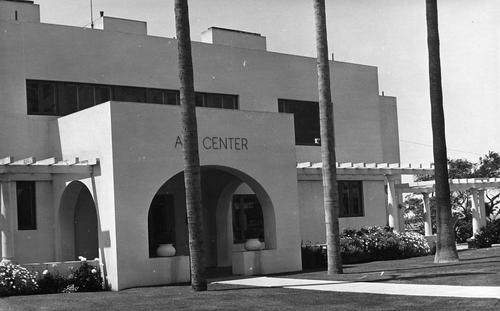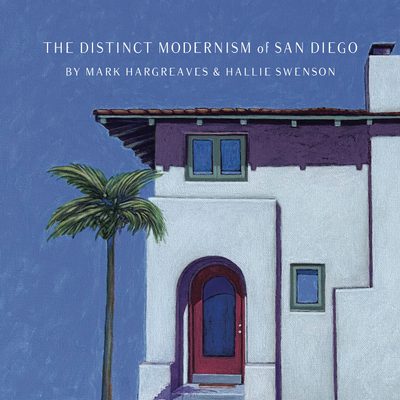Architecture
Laying The Groundwork: Pre-World War II Modernism

Mid-Century Modern did not appear unannounced in shelter magazines following World War II. A number of important people and designs brought ideas to life decades earlier and from hundreds, if not thousands, if miles away.
By Keith York

Modernism in San Diego arguably began with Irving Gill’s arrival in 1893. Gill borrowed from both the Arts and Crafts and Prairie architecture traditions. He was influenced heartily by his mentor Louis Sullivan and business partner William Hebbard.
In a 1916 issue of Craftsman, Gill described architecture as straight lines, simple cubes, and shear plain walls, un-adorned by cornices, overhangs or anything but a simple vine growing along the structure. In addition to plain walls of light color (referencing both the missions and the regional hot, dry climate), Gill instructed readers to appreciate the beauty and simplicity (as well as structural strength) of the arch. Gill’s preference for simplicity as well as his desire to organize a structure and its gardens would prove influential to logically designed buildings that leveraged the climate and embrace indoor-outdoor living following World War II.
Gill’s use of reinforced concrete and stark geometry can also be seen in Lillian Rice’s contributions to our region. Rice returned to National City in 1910 with more than a degree from UC Berkeley. She employed not only her Beaux-Arts based education in her work, but also the belief that buildings should be in harmony with their site and their environment through the use of indigenous natural materials. While Rice is recognized for her plan and construction supervision of downtown Rancho Santa Fe, while employed by Richard Requa and Herbert Jackson, her clean Spanish Colonial Revival designs were a departure from typical designs of the times. San Diego’s early modernists, Lloyd Ruocco and Sim Bruce Richards (among others), would adapt her vision of harmony in design in their own work.
Lillian Rice’s use of elements of mission style and adobe construction reinforced her intuitive interpretation of local tradition and climate. Her residential designs, like Gill’s, stressed the blending of house and garden. Homes by Rice, unlike many of her contemporaries were designed to unite the structures’ interior and exterior spaces by linking ceilings, wall surfaces and windows. Her design philosophies would carry forward in the indoor-outdoor living concepts pushed by Arts & Architecture and other progenitors of Southern California Post-War modernism.
Following a brief stint with Irving Gill (1907-1912), Richard Requa partnered with Frank L. Mead. Their early work may have reflected Gill’s designs, but soon their interest in Colonial Mexico, Pueblo, and Moorish styles gained acceptance as well-suited for the regional climate. Calling this style “Southern California Architecture,” historian Parker Jackson offered that Requa believed “that the design of the building, the landscaping and the terrain should all be compatible and complement each other.”
Beyond his work as Official Architect for the 1935 California Pacific International Exposition, and 1936 design work on the City-County Administration Building, Requa's Southern California Architecture nearly paralleled Gill’s ideas of structure bereft of ornamentation. Stressing stucco exteriors, tiled roofs, Moorish arches (akin to Cliff May’s early designs) and unique chimney designs, Requa’s office influenced a regional identity that would be further investigated by architects for decades.
Gaining notoriety for his invention of Lincoln Logs in 1916, and later for his 1946 book My Father Who is on Earth, John Lloyd Wright, son- and apprentice to Frank Lloyd Wright, would make significant contributions to San Diego’s mid-century legacy. Having moved to San Diego early in the century, John Lloyd Wright’s first job was with Harrison Albright on the Golden West Hotel in 1913. Later taking up residence in Del Mar, John would design and build a number of homes along the coast prior to the arrival of a great many architects in the Post-War years. Of the few to study with John Lloyd Wright, neighbor Herb Turner worked in his office for a mere .75 cents per hour. Turner would assist on many of Wright’s redwood structures, which often borrowed from his father’s Prairie influence, before striking out on his own as one of North County’s pre-eminent modernists.
If one structure in San Diego exemplifies pre-World War II modernity, it is Rudolf Schindler’s experiment in low-cost housing, Pueblo Ribera Courts (1923) in La Jolla. After practicing in Vienna and Chicago, Schindler came to Southern California to supervise construction of Frank Lloyd Wright’s Hollyhock House. According to Schindler historian Kurt Helfrich, having met Schindler, and been impressed with his early work, client Dr. W. Llewellyn Lloyd asked him to design “in a Southwestern manner” on his La Jolla land. The 12-unit Pueblo Ribera project illustrates Schindler’s desire to re-design the California modern home to enable communal indoor-outdoor living. With a bit of marketing, the owner was able to attract not only onlookers but profitable renters to his seaside retreat. Pueblo Ribera’s progressive design was enhanced by the healing properties of seaside indoor-outdoor living replete with sunbathing, athletic activities, beach time and outdoor fireplaces and rooftop sleeping porches.
One of the most significant influences on Pre-War modernism was the Bauhaus. Calling for more rational designs, Bauhaus architects, artists and craftspeople rejected bourgeois decorative detailing, by employing a pure form of architecture absent ornamentation. With flat roofs, stark color schemes, open floor plans, and cubic volumes with clean, smooth facades, the Bauhaus vocabulary readily exported from Germany to Southern California.
Disbanded as the Nazis rose to power, Walter Gropius, Marcel Breur, Mies van der Rohe and other Bauhaus leaders migrated to the United States. Seeing the rationale behind Bauhaus design ideology, Americans began to employ flat roofs over open floor plans illuminated by large banks of windows. Such design principles spread far and wide following the 1932 publication of The International Style by critic Henry-Russell Hitchcock and architect Philip Johnson in conjunction with an exhibition at the Museum of Modern Art in New York.
Arriving in San Diego in the early 1920’s, Lloyd Ruocco immersed himself, as a very young man, in San Diego’s thriving architectural community. His first position was as a draftsman in the offices of Richard Requa. Here, Ruocco was exposed to the Mediterranean styles that had become immensely popular throughout Southern California. Working in Requa’s office prior to his graduation from San Diego High School, Ruocco developed a sensitivity for siting and specifically the built environment’s relationship to the outdoors.
Following his graduation from Cal, Ruocco returned to San Diego and worked in the offices of Requa & Jackson and William Templeton Johnson. During this time he assisted on the 1935 California Pacific International Exposition (building construction models), County Administration Building (terrazzo mosaics outside of elevators), and also worked on the Alfred Mitchell Residence (1937) with Richard Requa. Ruocco also worked on the master plan for the community of Rancho Santa Fe under the supervision of his high school drafting instructor Lillian Rice. Within the Exposition’s Model Town, Ruocco and Kenneth Messenger displayed several models of designs for local International Style homes.
Growing increasingly dissatisfied with the rehashed revival styles that prevailed during the 1930s, Ruocco opened his own office in hopes of bringing a more modern style of architecture to San Diego. His early designs (1937-52) were almost exclusively exposed unmilled redwood with flat or shed roofs. His early designs made use of Schindler- and Gill-inspired concrete floors; large boulders on the building sites would pierce glass walls; and driftwood was used as towel hangers and other interior elements.
Lloyd Ruocco bridged Pre-War and Post-War design. His early work on the Robertson Residence (1941), Keller Residence (1942) and his first residence for himself (designed in 1941) all pre-dated U.S. entry into World War II.
While San Diego’s regionalism has rarely, if ever, been properly designed, there are indications that Post-War Modernism often tipped a hat to what came before. For example, Homer Delawie and Sim Bruce Richards exploited local adobe and post and beam construction in their designs; Russell Forester’s Mayne Residence (1962) exploited Gill’s arch; and Cliff May’s early San Diego work linked early Southern California Ranchos to open-plan Ranch Houses many decades later. Like Rice, May, a native San Diegan, contributed to the Spanish Revival by offering low-profile, red tile roofed dwellings surrounding walled-in courtyards. May’s interpretation of the Rancho significantly influenced Post-War architecture through his 1958 publication Western Ranch Houses where his regional use of Spanish and Moorish ideas migrated into defining the Ranch Style.
Have an idea or tip?
We want to hear from you!
email hidden; JavaScript is required

Architecture
Modern San Diego Stuff For Sale

Architecture
Streamline Modern(e) San Diego

Architecture